
by Larry Williams | Apr 23, 2020
One of the things to do while stuck at home due to COVID-19 restrictions, is to look for caterpillars and butterflies in your landscape. I’ve noticed giant swallowtail butterflies (Papilio cresphontes) a little early this year. The giant swallowtail is one of the largest and most beautiful butterflies in our area. Its larval stage is known as the orangedog caterpillar. This unusual name comes from the fact that it feeds on young foliage of citrus trees.
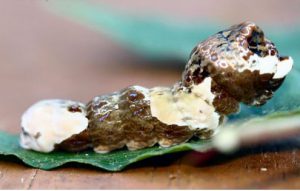
Orangedog caterpillar. Photo credit: Donald Hall, University of Florida
The orangedog caterpillar is mostly brown with some white blotches, resembling bird droppings more than a caterpillar. When disturbed, it may try to scare you off by extruding two orange horns that produce a pungent odor hard to wash off.
I’ve had some minor feeding on citrus trees in my landscape from orangedog caterpillars. But I tolerate them. I’m not growing the citrus to sell. Sure the caterpillars eat a few leaves but my citrus trees have thousands of leaves. New leaves eventually replace the eaten ones. I leave the caterpillars alone. They eat a few leaves, develop into chrysalises and then emerge as beautiful giant swallowtail butterflies. The whole experience is a great life lesson for my two teenagers. And, we get to enjoy beautiful giant swallowtail butterflies flying around in our landscape and still get plenty of fruit from the citrus trees. It is a win, win, win.
In some cases, the caterpillars can cause widespread defoliation of citrus. A few orangedog caterpillars can defoliate small, potted citrus trees. Where you cannot tolerate their feeding habits, remove them from the plant. But consider relocating the caterpillars to another area. In addition to citrus, the orangedog caterpillars will use the herb fennel (Foeniculum vulgare) and rue (Ruta graveolens) as a food source. Some butterfly gardens plant citrus trees to provide food for orangedog caterpillars so that they will have giant swallowtail butterflies. So you could plan ahead and grow some fennel, rue or find a butterfly garden in your area for the purpose of relocating the larvae.
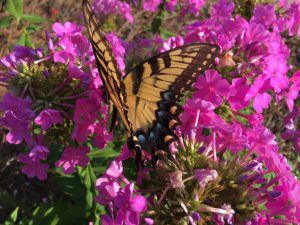
Yellow giant swallowtail butterfly on pink garden phlox flowers. Photo credit: Larry Williams
The adult butterflies feed on nectar from many flowers, including azalea, bougainvillea, Japanese honeysuckle, goldenrod, dame’s rocket, bouncing Bet and swamp milkweed. Some plants in this list might be invasive.
Keep in mind that mature citrus trees can easily withstand the loss of a few leaves. If you find and allow a few orangedog caterpillars to feed on a few leaves of a mature citrus tree in your landscape, you and your neighbors might get to enjoy the spectacular giant swallowtail butterfly.
More information on the giant swallowtail butterfly is available online at http://edis.ifas.ufl.edu/in134.
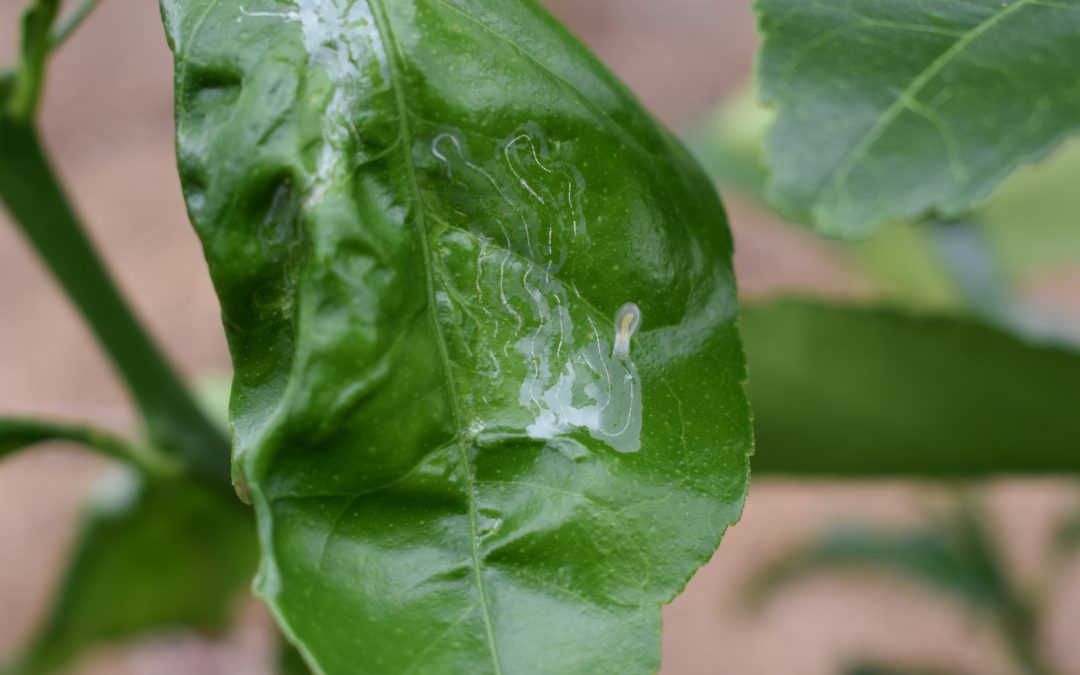
by Danielle S. Williams | May 20, 2019
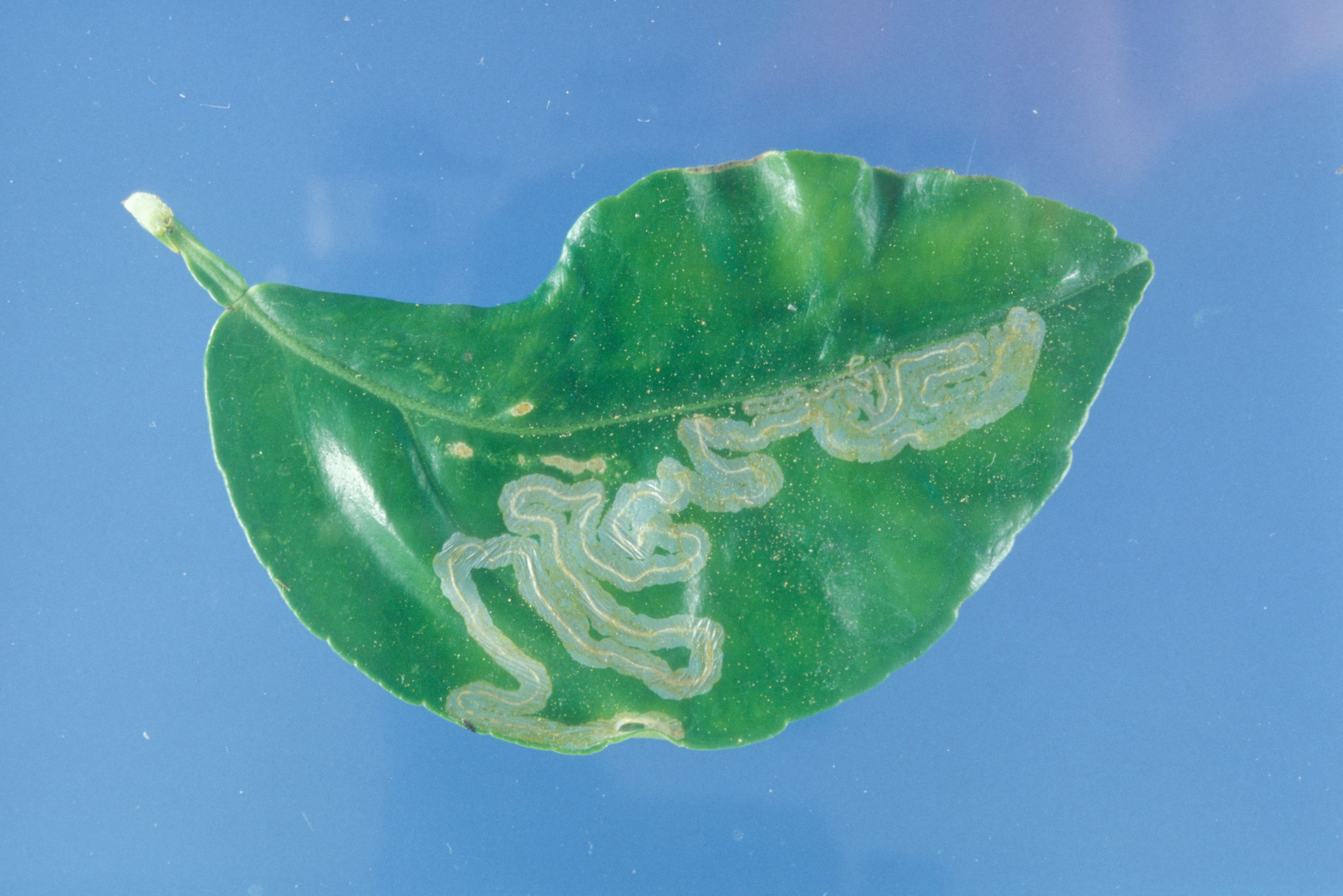
Citrus leafminer injury. Photo: James Castner
Spring is in full swing and citrus trees have begun actively flushing. With the new flush comes an array of insect pests. One of the most common being the citrus leafminer. The citrus leafminer is a small white moth, about 2.4 mm in length. It is more easily detected during its larval stage by the serpentine larval mines it produces on the underside of citrus leaves.
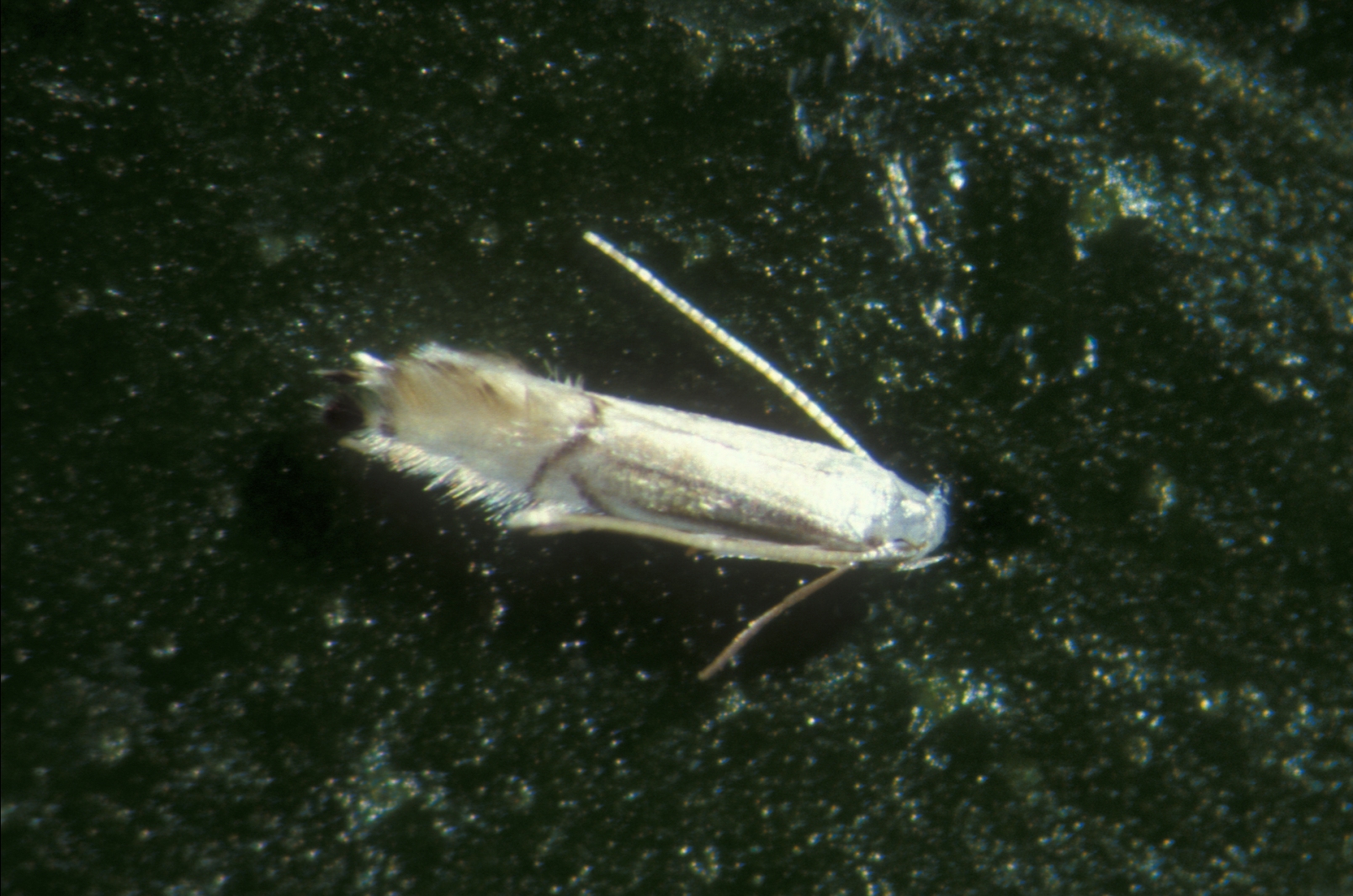
Citrus leafminer adult. Photo: James Castner
The larvae of the citrus leafminer feed on the new growth or flush of citrus causing serpentine mines to form under the leaf cuticle. This can result in leaf curling and distortion. Citrus leafminer injury to foliage can stunt the growth of young trees and in areas where the citrus canker pathogen is present, provide an opening for infection.
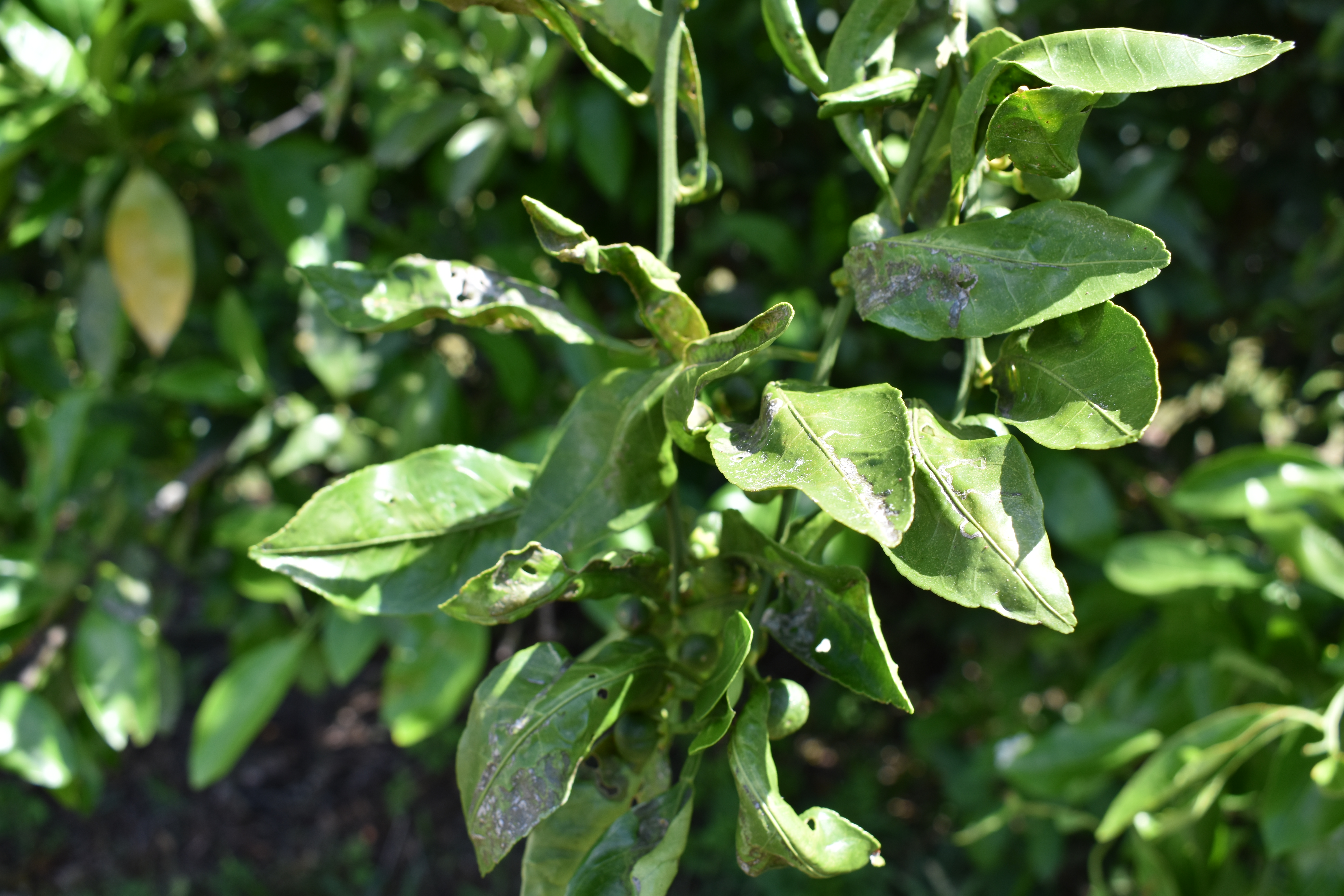
Distortion and leaf curling caused by citrus leafminer. Photo: Danielle Sprague
The term ‘flush’ is commonly used to describe the new foliar growth between bud break and shoot expansion. Citrus trees usually have several flushes per year, depending upon cultivar, climate and crop load. Generally, most citrus cultivars in our area have around three flushes. The main flush is the spring flush in late winter/early spring. Following that, two additional flushes occur around the end of June and late September.
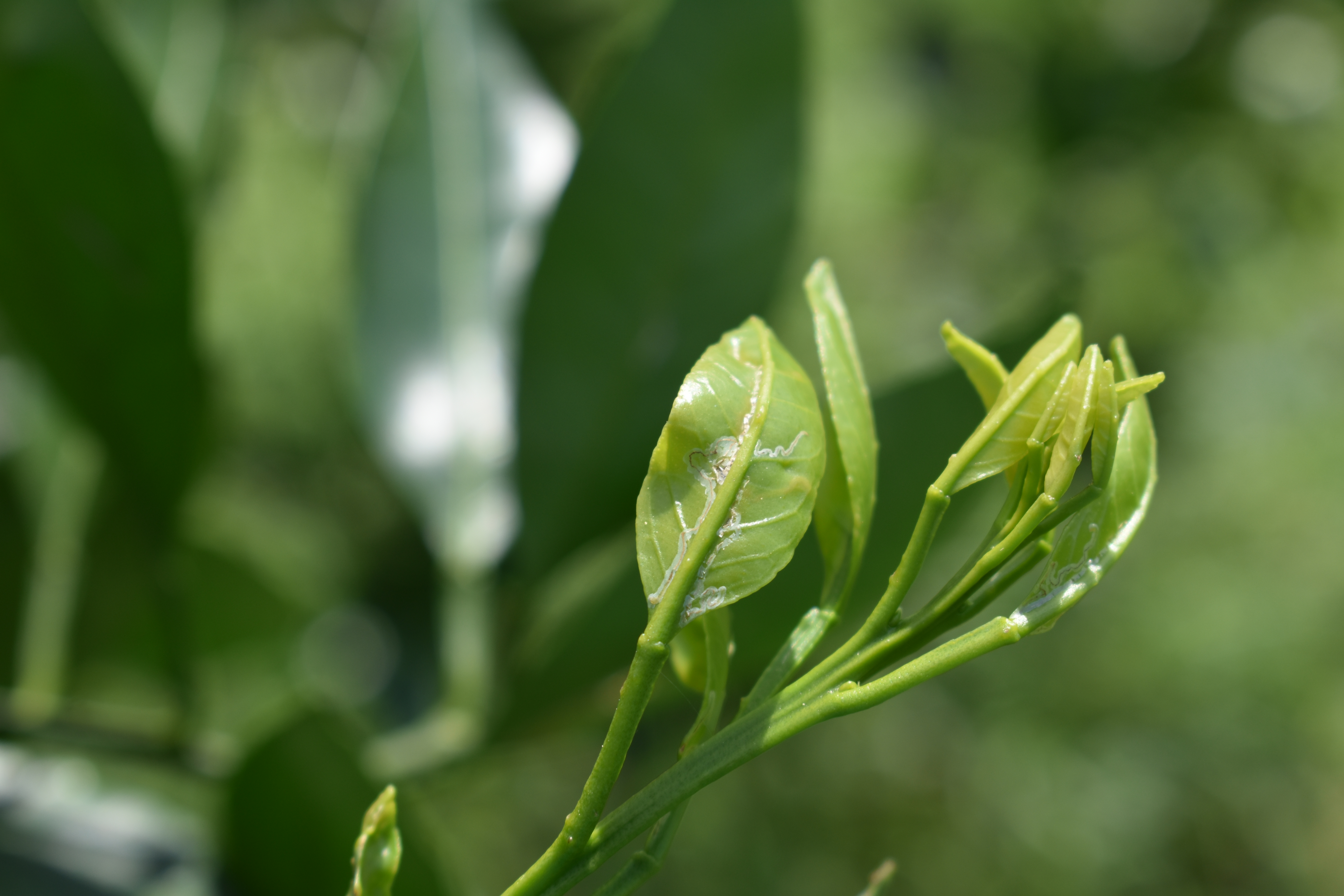
Citrus leafminer on young flush. Photo: Danielle Sprague
Adult leafminers require the new citrus flush for development. Eggs are laid within the flush. After two to ten days, the larvae emerge and feed causing the mines to occur. Larvae are protected within the leaf and therefore difficult to control. Pupation occurs within the leaf mine and takes anywhere from six to 22 days, depending upon temperature. Adults emerge around dawn and are most active in the morning and evening. In Florida, one generation of citrus leafminer is produced about every three weeks but populations increase when citrus trees are flushing.
In Florida, several natural enemies assist with reducing citrus leafminer populations. Studies have shown that predation from natural enemies can reduce leafminer populations by 90%. Primary predators of citrus leafminers include ants, lacewings and spiders. A parasitic wasp, Ageniaspis citricola was introduced into Florida and has become established. The parasitic wasp attacks the immature stages of citrus leafminer. Ageniaspis citricola can be requested and obtained for free from the Florida Department of Agriculture and Consumer Services (FDACS). Because it is a specialized parasitoid of the citrus leafminer larval stage, it should be released only when mines start to become visible on flush.
Citrus leafminer can be difficult to control with insecticides due to the fact that they are within the leaf and protected. Applications of insecticides require proper timing and may require repeat applications. For a full list of insecticides, contact your local Extension Office.
For more information on citrus leafminer, use the links to the following publications:
Citrus Leafminer, Phyllocnistis citrella Stainton (Insecta: Lepidoptera: Phyllocnistinae)
Citrus Leafminer Control – UGA
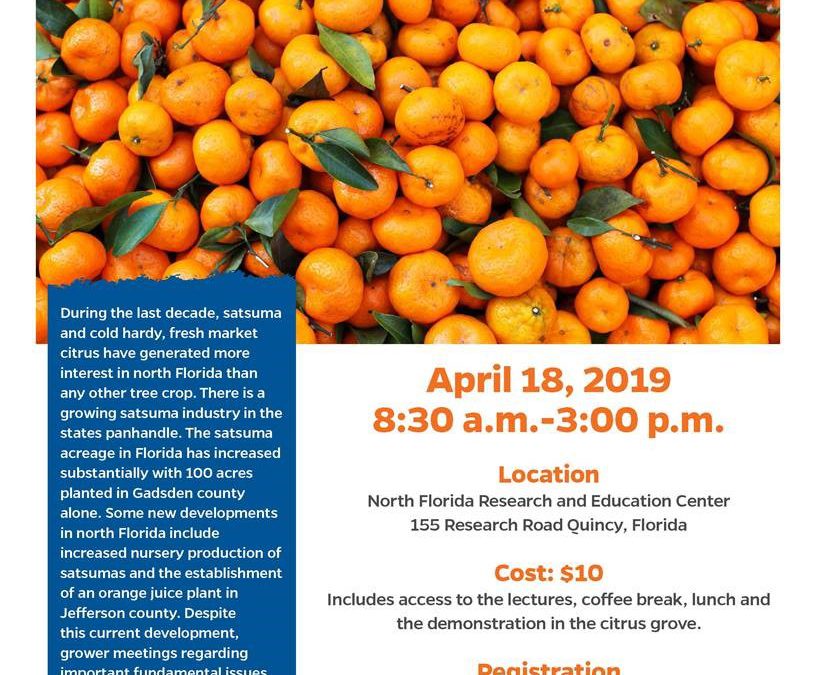
by Matthew Orwat | Apr 9, 2019
Citrus growers from across the Florida Panhandle, as well as southern Georgia and Alabama are invited to attend the 2019 Citrus Health Forum. The workshop will be held at the UF/IFAS North Florida Research and Education Center in Quincy (155 Research Road, Quincy, FL). Registration begins at 8:30 AM EST with the meeting starting at 9:00 AM and concluding at 3:00 PM. The workshop registration fee is $10 and includes refreshments and lunch.
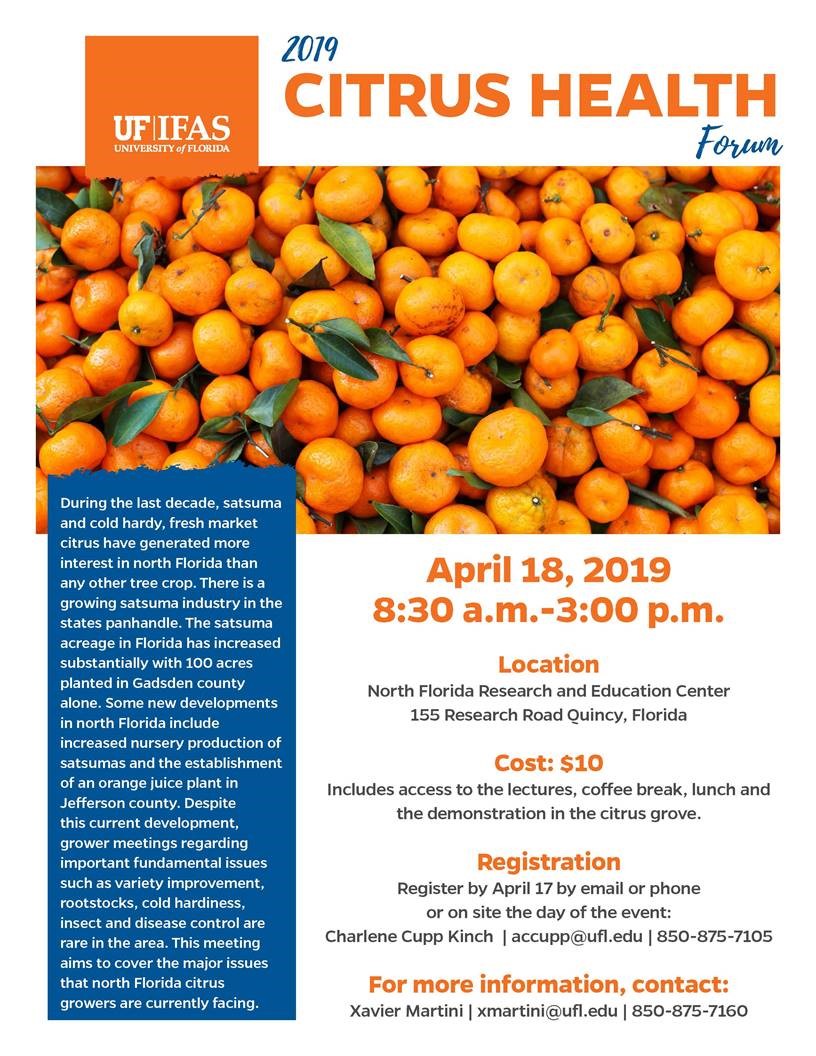
AGENDA:
A.M (all times Eastern)
8:30 Registration
9:00 Welcome – Dr. Glen Aiken, UF/IFAS NFREC-Center Director
9:15 Cold Hardy Citrus Varieties for North Florida – Dr. Pete Andersen, UF/IFAS NFREC Horticulture
9:45 Arthropod Pests of Citrus – Dr. Lauren Diepenbrock, UF/IFAS CREC Entomology
10:15 Unexpected Diaprepes abbreviatus Infestations in North Florida – Dr. Russ Mizell, UF/IFAS NFREC Entomology
10:30 Break
10:45 Citrus Canker, Alternaria and Scab Diseases of Citrus – Dr. Megan M. Dewdney, UF/IFAS CREC Plant Pathology
11:15 Phytophthora Management and HLB Basics – Dr. Evan G. Johnson, UF/IFAS CREC Plant Pathology
11:45 Lunch
12:45 Detection of HLB by Canines – Dr. Tim R. Gottwald, USDA Plant Pathology
1:10 Asian Citrus Psyllid Distribution and Management in North Florida – Xavier Martini, UF/IFAS NFREC Entomology
1:35 Enterprise Budgets for Satsuma in North Florida – Dr. Kevin R. Athearn, UF/IFAS Economist
2:00 Detection of HLB by Canines: Field Demonstration – Bill Moraitis, F1K9
To register, please contact Charlene at accupp@ufl.edu or by phone at 850-875-7105. For more information on the meeting, or to help sponsor the event, contact Xavier Martini at xmartini@ufl.edu or 850-875-7160.
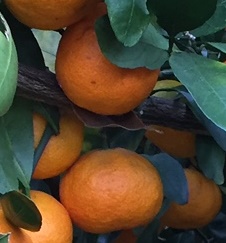
by Matthew Orwat | Jan 4, 2018
Every winter season in the Florida Panhandle is different. It can be wet or dry, frigid cold or unseasonably warm. We may have early frosts and early springs, or cold snaps in late march after fruit trees flower.
While we cannot determine the exact time to prune the dooryard fruit trees in our rather variable region, here are some tried and true guidelines for pruning the most popular edible garden plants in northwest Florida.
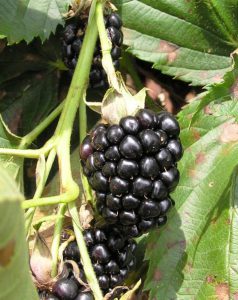 Blackberries
Blackberries
Blackberries are unusual in that they do not build a large structure and fruit for years on the same branches (in general). They actually fruit on previous years’ growth which then die after fruit production. The canes that produce fruit are called the floricanes. As the floricanes are producing fruit, the blackberry plants are growing primocanes. These are the new canes that will produce fruit for the next season. By then, these canes will have matured in to floricanes. A few new blackberry cultivars exist that produce fruit on new growth as well, but most Florida adapted cultivars are of the standard type. For pruning purposes, it is best to remove the floricanes just after fruiting, but be sure not to cut the new growth (primocanes) because that wood will bear next year’s fruit. For more information about the blackberry, please see publication HS807.
Blueberries
With blueberries older canes need to be removed to make room for younger, more productive canes. When a plant reaches four to five years old it is permissible to remove about 1/4–1/5 of the oldest canes each year which amounts to about one to three of the oldest canes. Performing this task will ensure that no cane is more than three or four years old. Thus, blueberry plantings will be in a constant state of renewal and not become excessively woody and nonproductive. To keep plants from becoming too tall, mature plants can be topped in the summer directly after fruit harvest. Removal of a few inches to a foot, depending on the cultivar, will stimulate the new growth that will bear the next year’s fruit. See CIR 1192 for more information
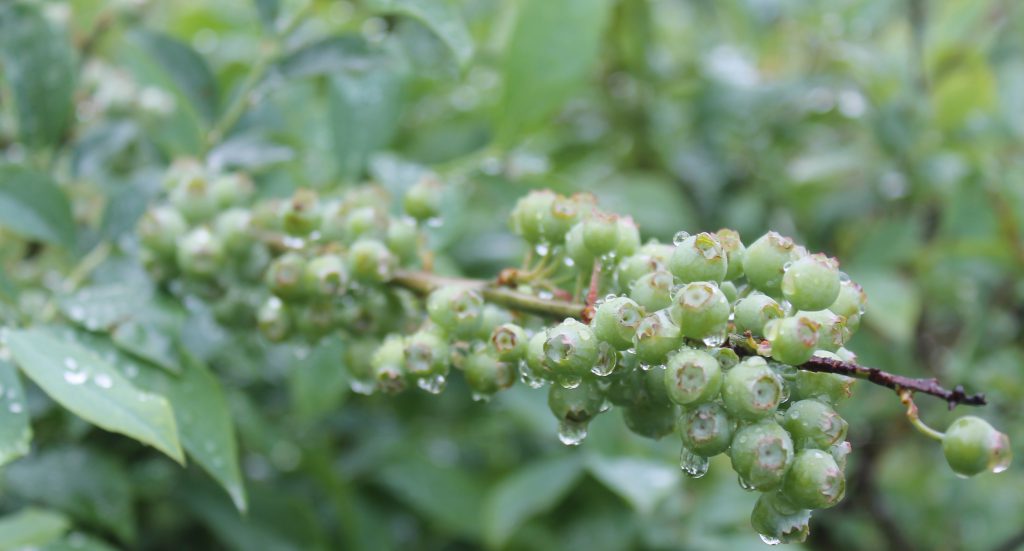
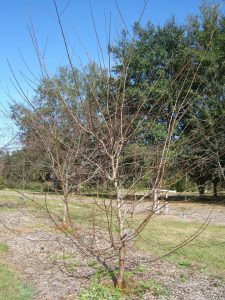 Temperate Fruit Trees
Temperate Fruit Trees
Pruning of temperate fruit trees (Peaches, Apples, Pears, Persimmons) should be done during the winter dormant period in most cases. This period, generally between December and February allows for some latitude. Pruning later in the dormant season is better in most seasons since trees are more susceptible to freeze damage after pruning, and pruning stimulates the growth of the trees. In Northwest Florida, a February pruning is usually most desirable, depending on the season (namely average high temperatures). Pruning for shape is also done in the summer months if necessary. This task should be limited to removing excessive growth and dead / diseased wood. See HS1111 and HS14 for more information.
Muscadines
Once harvest concludes, it is usually a grower’s natural inclination to immediately prune their muscadine vines. Pruning after harvest in early fall is not, however, best for maintaining plant condition and optimizing next year’s yield, especially if there is an early frost. Early frosts can surprise the plant before sugars have been moved to the roots for storage during dormancy. Therefore, waiting to prune in mid-January to mid-March will ensure that the vine has had adequate time to go dormant and acclimate to the winter season. For more information please see this article titled “Tips for Properly Pruning Muscadines”.
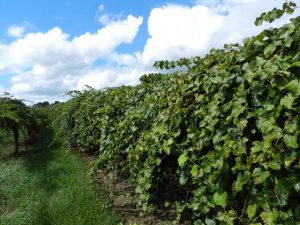
 Citrus
Citrus
Pruning is not necessary for citrus in every case, as it is in many temperate fruits, to have excellent production quality and quantity. Citrus trees perform excellently with minimal pruning. The only pruning necessary for most citrus is removing crossing or rubbing branches while shaping young trees, removing dead wood, and pruning out suckers from the root-stock. Homeowners may choose to prune citrus trees to keep them small, but this will reduce potential yield in a commercial setting, since bigger trees produce more fruit.
Often, maturing Satsuma trees produce long vertical branches. It is tempting to prune these off, since they make the tree look unbalanced. To maximize yield, commercial Satsuma growers allow these branches to weep with the heavy load of fruit until they touch the ground. This allows increased surface area for the tree, since the low areas around the trunk are not bare. Additionally, weeds are suppressed since the low branches shade out weed growth. The ground under the trees remains bare, thus allowing heat from the soil to radiate up during cold weather events. The extra branches around the trunk offer added protection to the bud union as well. If smaller trees are desired for ease of harvest, ‘flying dragon’ root-stock offers dwarfing benefits, so that the mature scion cultivar size will only grow to 8-10 feet tall.
Fig
Figs should be pruned after fruit production, which usually occurs in early summer. In the winter it is fine to remove dead or diseased wood, but drastic trimming will reduce yield since fruit is borne at the terminal of the previous year’s growth. For more information, please consult publication HS27.
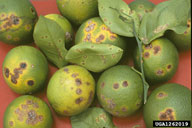
by Mary Salinas | May 11, 2017

Citrus canker symptoms on twigs, leaves and fruit. Photo by Timothy Schubert, FDACS
In November 2013, citrus canker was found for the first time in the Florida panhandle in Gulf Breeze in southern Santa Rosa County. The Florida Department of Agriculture and Consumer Services (FDACS) tested and confirmed the disease on grapefruit trees in a residential landscape. Since that time, citrus canker has been confirmed on citrus trees at 27 more locations in Gulf Breeze. To my knowledge it has not been found in any other location in the panhandle. Not yet.
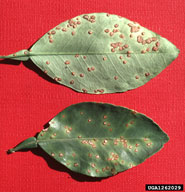
Citrus canker lesions on leaves are raised, rough and visible on both sides of the leaf. Photo by Timothy Shubert, FDACS.
Citrus canker is a serious bacterial disease that only infects citrus trees. It will not infect any other plant species nor is it a threat to human health. This highly contagious disease has no cure as yet. Severely affected trees experience substantial leaf and premature fruit drop and serve as a source for infecting other citrus in the area. The disease spreads through wind, rain and transportation of infected plant material from other locations.
We do not know how the disease came to infect trees in our region. The disease could have been spread through infected fruit or trees brought here from areas where the disease is established, such as central or south Florida.
What should you do if you suspect your citrus is infected with this disease?
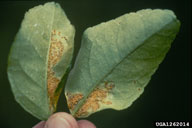
Citrus canker lesions can appear in the mines left by the citrus leafminer pest. Photo by Timothy Schubert, FDACS
- Look at Homeowner Fact Sheet: Citrus Canker for more information.
- Leave the tree in place in your yard and call the Division of Plant Industry at FDACS at 1-888-397-1517 for a free inspection and testing of your citrus trees.
- Consult your local Horticulture Extension Agent for more information and control/removal strategies.
- Proper removal of infected trees is recommended to prevent the spread of citrus canker but is not mandatory.
For more information please see:
Save Our Citrus Website
UF IFAS Gardening Solutions: Citrus
Citrus Culture in the Home Landscape
UF IFAS Extension Online Guide to Citrus Diseases


















